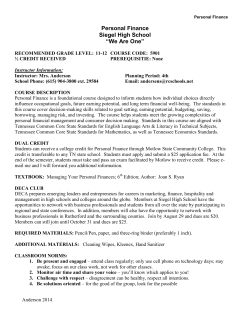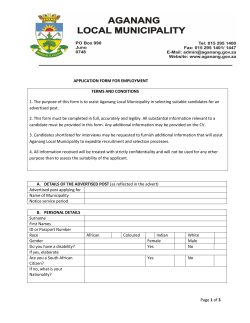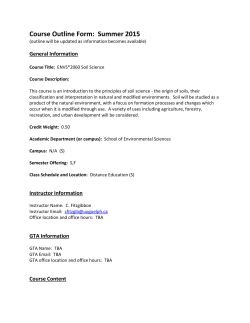
March 30, 2015
AGENDA Disciplinary System Review Committee Monday, March 30, 2015 OSB Center, Tigard, Oregon 3:00 p.m. Teleconference: 1-888-737-5834, passcode 450552 1. Approve minutes of February 23, 2015. 2. Probable Cause Subcommittee a. Report and Recommendations for Discussion b. Minutes (information only) 3. Continue discussion of SPRB Function pursuant to the Work Plan 4. Meeting Schedule (all are Mondays at 3 p.m.): April 27 May 18 June 22 Minutes OSB Discipline System Review Committee Meeting Date: Location: Chair: Attendance: February 23, 2015 Oregon State Bar Center, Tigard, Oregon Mark Johnson Roberts Chelsea Armstrong, Kenneth Bauman John Beckfield, Bill Blair, Nancy Cooper, David Elkanich, Mark Fucile, Bill Hopp, Scott Howard, Jeff Howes, Wayne Mackeson, Mark Morrell, Arden Olson, Doug Querin, Bruce Rubin, Jana Toran-Crumpacker, Richard Weill, Jane Yates BOG Liaisons: Ray Heysell Supreme Court Liaison: Lisa Norris-Lampe, Hon. Martha Walters OSB Staff: Amber Bevaqua-Lynott, Dawn Evans, Helen Hierschbiel, Sylvia Stevens 1. Call to Order; Approval of Minutes. Mr. Johnson Roberts called the meeting to order at 3:05 p.m. On motion of Ms. Norris-Lampe, seconded by Ms. Toran-Crumpacker, the minutes of the January 26, 2015 meeting were approved unanimously. 2. Work Plan. Mr. Johnson Roberts explained the Work Plan he’d drawn up and how he expected to use it subsequent meetings. At the suggestion of Ms. Toran-Crumpacker, a final topic of “General/Miscellaneous” to capture ideas not included in the ABA evaluation or that arise as the group works through the issues identified by the ABA. 3. Rules Format. Mr. Johnson Roberts said he has no position on the issue, but inquired whether others had opinions about whether the group should make its changes to the existing Oregon Bar Rules of Procedure or to recommend adopting the ABA Model Rules for Disciplinary Enforcement as tailored to Oregon. After discussion, there was a general consensus in favor of incorporating any changes into Oregon’s BR structure. 4. SPRB Review of DCO Dismissals. Mr. Johnson Roberts presented the issue as whether the SPRB should review matters dismissed by DCO for lack of probable cause. Ms. Evans provided a brief overview of the process, including the fact that request for SPRB review have declined by more than half since we stopped informing complainants of the opportunity for SPRB review. She also explained that the standard for CAO to refer a matter to DCO is whether the facts, if true, support a “reasonable belief” that misconduct may have occurred. The group identified three options: shift the responsibility to the SPRB chair, as recommended by the ABA; have the review by a smaller subcommittee of the SPRB; continue the current process where the review is conducted by the entire SPRB. Pros and cons of each option were discussed. Also discussed was whether there should be any review of DCO dismissals. Motion: Ms. Toran-Crumpacker moved, seconded by Ms. Cooper, (1) to continue the SPRB review of DCO dismissals, with the SPRB chair authorized to delegate the review to one or more SPRB members; (2) that complainants have 30 days to submit a request for SPRB review; and (3) that the SPRB have 30 days (or until its next meeting) from receipt of the request to conduct the review. Mr. Beckfield voted no; all others voted yes. 5. Limit SPRB Authority to Probable Cause Determination. While there was a general consensus that the most important function of the SPRB is to make charging decisions, there was considerable discussion of continuing the SPRB’s discretion to assess whether a case should be prosecuted, notwithstanding a finding of probable cause. Concern was voiced that the existing rules do not give sufficient guidance to the SPRB about what constitutes “probable cause” or about the other factors that should be considered in determining whether to authorize prosecution. BOG Committee Minutes — OSB Discipline System Review Committee February 23, 2015 Page 2 Mr. Weill offered as an example the US Attorneys Manual 9.27.220, which allows the government to decline prosecution notwithstanding the existence of probable cause when: (1) no substantial federal interest would be served by the prosecution; (2) the person is subject to effective prosecution in another jurisdiction; or (3) there exists an adequate non-criminal alternative to prosecution. Motion: On motion of Mr. Blair, seconded by Richard Weill, the committee voted unanimously to have a subcommittee develop a definition of probable cause and to review and make recommendations regarding the factors the SPRB can consider in exercising its discretion to decline to proceed with formal charges. Mr. Johnson Roberts then appointed a subcommittee comprised of Mr. Blair, Mr. Ellis, Mr. Howes, and Ms. Norris Lampe, and encouraged the subcommittee to bring its recommendation to the next meeting. Discussion on the issue continued, with the observation that the criminal grand jury model isn’t a perfect analogy since the grand jury isn’t involved in the prosecutor’s exercise of discretion not to prosecute even where the grand jury has found probable cause; the grand jury is also not involved in the prosecutor’s subsequent decisions regarding the handling of the case. Motion: On motion of Ms. Toran-Crumpacker, seconded by Ms. Armstrong, the committee voted unanimously to recommend that the SPRB review cases for probable cause of misconduct that can be proven by clear and convincing evidence. The scope of the SPRB’s authority once prosecution has been authorized will be discussed further at subsequent meetings. 6. Sharing DCO Charging Memo with the Respondent. There was considerable divergence of opinion as to whether Respondents and their counsel should be allowed to see DCO’s analysis of the facts that support their charging recommendations. One view was that allowing Respondent to address the issues at that stage might better enable DCO and the SPRB to evaluate the case. On the other hand, it was pointed out that the SPRB is not an adjudicatory body and allowing Respondents to challenge DCO at that stage would change the nature of the SPRB’s deliberations and add time rather than shorten the process. Other points raised were: Concerns about protection of attorney work product Implications of the public records and meetings law Whether DCO should submit a draft formal complaint to the SPRB along with its charging memo The extent to which the SPRB should be involved in amendments to a formal complaint after prosecution is authorized (other than with regards to new, unrelated misconduct) To aid the committee’s further analysis of this issue, staff will provide samples of the Complaint Summary provided to the SPRB. Motion: Justice Walters, seconded by Mr. Blair, moved to recommend that the SPRB approve a specific complaint, which would be provided to the Respondent in advance of SPRB consideration. Ms. Armstrong, Mr. Weill and Ms. Toran-Crumpacker voted no; Ms. Yates abstained; all others voted yes. There being no further business, the meeting adjourned at 5:05 p.m. OSB DISCIPLINARY SYSTEM REVIEW COMMITTEE Probable Cause Subcommittee 1 Report and Recommendations Summary The subcommittee was charged with (1) finding a definition for “probable cause” and (2) identifying factors to be considered when exercising discretion not to pursue a matter notwithstanding the existence of probable cause. The subcommittee met twice for 60 and 90 minutes, respectively. On the first issue, there was agreement that a “mere” finding of probable cause was not enough to justify going forward; rather, DC should also be reasonably confident that misconduct can be proved by clear and convincing evidence. The group also agreed to characterize the standard as “cause for a formal complaint.” This is proposed as a defined term that would substitute throughout the BRs for “probable cause.” On the second issue, the subcommittee recommends adding two new factors to be considered in exercising discretion decline or dismiss a matter, even where there is cause for a formal complaint. As written, the recommended language would replace what is currently BR 2.6(f)(3) (SPRB discretion to dismiss a complaint or allegation of misconduct), but the subcommittee acknowledges that BR 2.6(f)(2) (SPRB discretion to direct that Bar take no further action, based on separate factors) may also need to be revised. This recommendation vests concurrent discretionary authority with both DC and the SPRB prior to the SPRB authorizing a formal complaint. After a formal complaint is filed, only the SPRB may authorize dismissal before the case has been assigned to a trial panel, and thereafter the DB State Chair must authorize dismissal. This maintains the concept that once a case has been assigned to a trial panel, the DB has sole jurisdiction over the matter while relieving the trial panel chair of the need to become involved in the merits of a case that may not be dismissed under these guidelines. Recommendations Rule 1.1 Definitions (#) “Cause for a formal complaint” means that, based on credible evidence, there is a reasonable belief that: (1) An attorney has engaged in misconduct 2, and (2) The evidence is clear and convincing, and will probably sustain a finding of misconduct. 1 William Blair, Barnes Ellis, Jeffrey Howes, Richard Weill (Sylvia Stevens, Dawn Evans and Lisa NorrisLampe) 2 “Misconduct” is defined in BR 1.1(s) as “any conduct which may or does subject an attorney to discipline Act under the Bar or the rules of professional conduct adopted by the Supreme Court. Rule X.X Alternative disposition of complaint of misconduct. (1) Even if there is cause for a formal complaint, a formal complaint may be declined or dismissed by Disciplinary Counsel or the SPRB if, considering the facts and circumstances as a whole, declining to proceed or dismissal would further the interests of justice and would not be harmful to the interests of clients or the public. Factors that may be taken into account in exercising discretion under this rule include, but are not limited to: (a) The attorney’s mental state; (b) Whether the misconduct is an isolated event or part of a pattern of misconduct; (c) The potential or actual injury caused by the attorney’s misconduct; (d) The nature and extent of the attorney’s cooperation in the investigation of the misconduct; (e) Whether the attorney previously was admonished or disciplined for misconduct; (f) Whether, given the probable outcome of the case, formal proceedings are an appropriate use of resources; and (g) The amount of time that has elapsed since the misconduct occurred. (2) Misconduct that adversely reflects on the attorney’s honesty, trustworthiness, or fitness to practice law shall not be subject to dismissal under this rule. (3) Notwithstanding subsection (1) of this section, Disciplinary Counsel may not dismiss a formal complaint without the approval of: (a) The SPRB, if the case has not yet been assigned to a trial panel of the Disciplinary Board, or (b) The State Chair of the Disciplinary Board if the case has been assigned to a trial panel. Minutes OSB DSRC Probable Cause Subcommittee Meeting Date: Location: Attendance: March 6, 2015, 12:00 noon Teleconference Bill Blair, Barnes Ellis, Jeffrey Howes, Richard Weill, Lisa Norris-Lampe, Dawn Evans, Sylvia Stevens The meeting began with a discussion of the scope of the subcommittee’s work, specifically whether the meaning of “probable cause” was the problem? Ms. Evans offered that her staff shared a common understanding of the phrase. The following points were raised: • • • • • Creating a new definition will create confusion, as the court has already said that the statutory definition applies in lawyer discipline matters. Probable cause is basic to due process and there is no reason to change its accepted meaning. The discretionary aspect of the charging decision is where concerns lie. Probable cause is the threshold; without it the exercise of discretion doesn’t come into play. “Should the case be brought” is the proper standard and analogies to the criminal system aren’t apg. The discretionary aspect should include an assessment of whether the prosecution will succeed; it is a factor in both state and federal prosecutorial discretion. After discussion, the group agreed (3-1) to recommend that charging decisions be based on “probable cause” as well as an assessment of whether there is evidence to support a finding of misconduct, using language similar to what is in the US Attorney’s Manual §9-27.220. Discussion then turned to the appropriate discretionary factors that should be considered. Suggested factors were: • Cost of proceedings vs. desired/probable outcome • Novelty of the issues, including the area of law in which the conduct occurred • Did anyone complain?; was anyone harmed? • Character of the respondent and whether this is a first offense The group noted that BR 2.6(f) has two sets of factors, one that appears to be applied in advance of the decision to file formal proceedings and the other during the formal proceedings. Should there be a single set of factors that are applied any any stage? The final area of discussion was whether expanding the discretionary factors will create an opportunity for Respondents to argue they all apply? Will it make the SPRB process even longer and more complex? Mr. Blair said there are two things that will address those concerns: • Limit the number of request for reconsideration • No reconsideration of SPRB’s discretionary assessment Subcommittee members will draft and submit their ideas for additional discretionary factors for consideration by the group at its next meeting. Ms. Stevens will draft the probable cause language. The next meeting will be March 18 at 9:00 p.m. by teleconference. Minutes OSB DSRC Probable Cause Subcommittee Meeting Date: Location: Attendance: March 18, 2015, 9:00 a.m. Teleconference Bill Blair, Barnes Ellis, Jeffrey Howes, Richard Weill, Lisa Norris-Lampe, Dawn Evans, Sylvia Stevens The group reviewed three alternative proposals, one prepared by staff, one from Mr. Ellis and one from Mr. Blair. Discussion began with consideration of Mr. Blair’s suggestion to substitute the concept of “Cause for a formal complaint,” which includes an evidentiary standard, for the current “probable cause.” Ms. Evans questioned whether there might be unintended consequences from adopting a standard unique to Oregon; she also wondered whether adding the evidentiary piece will require DCO to build its entire case before taking a matter to the SPRB. She also pointed out that the strength of the bar’s evidence is always a consideration when DCO recommends that formal proceedings be instituted. After discussion, the group was unanimously in favor of recommending the “cause for a formal complaint” structure. Not only will it further distinguish disciplinary matters from criminal proceedings, but an explicit statement of the considerations for proceeding with formal charges will make the process more transparent. The group then turned to the list of discretionary factors that can be considered by the SPRB in deciding not to proceed notwithstanding the belief that misconduct has occurred and can be proved by clear and convincing evidence. Ms. Evans explained that BR 2.6(f) currently has two facets: (1) the SPRB can decide to “take no further action” when the circumstances or other pending proceedings will adequately address the misconduct and (2) the SPRB can “dismiss” a matter based on variety of other factors relating to the lawyer or the nature of the case. There followed a brief discussion of whether the “take no action” was the equivalent of a dismissal without prejudice, while “dismissal” was meant to be with prejudice or be the equivalent of an exoneration. It may ultimately be possible to collapse all the standards into one, but it was agreed that issue was outside the subcommittee’s charge. After discussion, the group was unanimously in favor of adding two discretionary factors suggested by Mr. Ellis: whether undertaking formal proceedings was an appropriate use of the bar’s resources, and the length of time that has elapsed since the alleged misconduct. It was also agreed to retain “misconduct that reflects adversely on the attorney’s…fitness to practice” among the kinds of behavior that is not subject to discretionary dismissal. Mr. Blair acknowledged that his proposal is a structural change that defines who has authority to make discretionary choices about whether or not to proceed formally. While not within the charge of the subcommittee, Mr. Blair indicated he envisions that complainants will have some right to SPRB review of DCO dismissals. Ms. Stevens will prepare a report and recommendations for submission to the full DRSC and will circulate it to the subcommittee for comment. WORK PLAN OSB Discipline System Review Committee Bar Rules of Procedure discussion I. State Professional Responsibility Board (SPRB) A. Function 1. Reviewing DCO Dismissals 2. Making Probable Cause Determinations 3. Reconsideration of Prosecution Decision 4. Reporting Crimes 5. Directing DCO Not to Proceed 6. Continuing Jurisdiction (settlements etc.) 7. Making Appeal Decisions B. Appointment, Size and Composition 1. Appointment authority 2. Number of public members 3. Acting in panels C. Training (staff) II. Disciplinary Counsel and Disciplinary Counsel’s Office A. Writing a Rule—yes—what components? B. Autonomy 1. Appointment Authority 2. Who Is the Client? 3. Non-Disciplinary Regulatory Functions 4. Webpage & Identity Package (“letterhead”) (staff) C. Prosecutorial Discretion 1. Discipline on Consent 2. Prosecution of Complaint D. Temporary Suspension 1. Generally 2. Conviction of Crime E. Technology (staff?) F. Business Continuity Plan (staff?) G. Records Retention Policy (staff) III. Local Professional Responsibility Committees (LPRC) IV. Client Assistance Office (CAO) A. Rapid Resolution Procedure B. Training (staff) V. Diversion FEB 23 FEB 23 MAR 30 APR 27 MAY 18 JUNE 22 VI. Disciplinary Board and Trial Process A. One Statewide Board/Discipline Judge B. Appointment to Case C. Reconsideration of Prosecution Decision D. Extensions of Time E. Pretrial Conferences F. Rules of Evidence 1. Generally 2. Prior Acts of Misconduct a) Charging b) Adjudication c) Sanction G. Staffing the Disciplinary Board H. Training (staff) VII. Probation VIII. Modernizing Language in the Bar Rules (staff to make proposal) IX. X. XI. XII. Appointment Processes Reciprocal Discipline Reinstatement Death, Disappearance, Suspension and Disbarment A. Resignation During Proceedings (“Form B”) B. Custodian or Trustee C. Duties of the Disciplined Lawyer [JULY 27] [AUG 24] [SEP 28] [OCT 26] [NOV 23] [DEC 21]
© Copyright 2025









